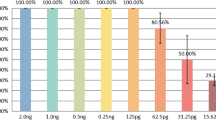Abstract.
In this study 14 Y-STR loci (DYS393, DYS19, DYS391, DYS437, DYS435, DYS439, DYS389II, DYS438, DYS436, DYS390, Y-GATA-H4, DYS385, Y-GATA-A7.1 and DYS392) were analysed in 207 Japanese males from Honshu (main island of Japan, Nagoya City) and 87 Japanese males from Okinawa (southernmost islands of Japan) using two multiplex PCR typing systems, a novel 10-plex amplification system and a new commercially available 6-plex typing kit which had two loci in common. The allele frequency distributions were similar at almost all of the 14 loci. Of the haplotypes observed, 244 were unique in both Japanese populations and 17 haplotypes were observed more than once but the 2 populations shared only 7 haplotypes. The haplotype diversities for the 14 loci were 0.9987 and 0.9976 in Honshu and Okinawa Japanese, respectively. The haplotype analysis at 14 Y-STR loci would be useful for personal identification in forensic fields and for population genetics because of the high divergence of these haplotypes.
Electronic supplementary material to this paper (Table S1) can be obtained by using the Springer Link server located at http://dx.doi.org/10.1007/s00414-002-0319-6
Similar content being viewed by others
Author information
Authors and Affiliations
Additional information
Electronic Publication
Rights and permissions
About this article
Cite this article
Uchihi, R., Yamamoto, T., Usuda, K. et al. Haplotype analysis with 14 Y-STR loci using 2 multiplex amplification and typing systems in 2 regional populations in Japan. Int J Legal Med 117, 34–38 (2003). https://doi.org/10.1007/s00414-002-0319-6
Received:
Accepted:
Issue Date:
DOI: https://doi.org/10.1007/s00414-002-0319-6




